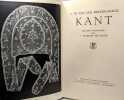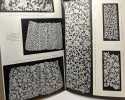Van der meulen-nulle
Kant
H.J. Paris 1936 in8. 1936. Cartonné.
Reference : 100130042
couverture défraîchie ternie intérieur propre
Bookseller's contact details
Un Autre Monde
M. Emmanuel Arnaiz
07.69.73.87.31
Payment mode
Sale conditions
Conformes aux usages de la librairie ancienne.
5 book(s) with the same title
Kant intime. Textes traduits de l’allemand, réunis et présentés par Jean Mistler.
Grasset, 1986. In-12 broché, couverture illustrée, à peine jaunie - pour le reste, à l’état de neuf.
Die Religion innerhalb der Grenzen der blossen Vernunft. - [ONE OF NO MORE THAN A HANDFUL COPIES ON SPECIAL PAPER, GIVEN BY KANT TO HIS CLOSE FRIEND HASSE]
Königsberg, Friedrich Nicolovius, 1793. 8vo. In the original bluish cardboardbinding, with handwritten title to spine. Binding very neatly restored at spine and extremities. Previous owner's inscriptions to front free end-paper and title-page as well as pasted-down front end-paper. One leaf with a tiny closed tear to blank outer margin and some leaves with a single hole to the blank outer margin. Light pencil-underlinings and -markings to a few leaves. Internally clean and fresh. Printed on very heavy paper (about three times the thickness of the normal paper) and with wide margins. XX, (2), 296, (2, -errata) pp. Housed in a beautiful marbled half calf box in pastiche-style, with splendidly gilt spine and gilt morrocco title-label.
Extremely rare presentation-copy inscribed by the recipient, a close friend of Kant, Johann Gottfried Hasse, to whom Kant gave the present copy. The copy is one of no more than perhaps five copies printed on special paper of the first edition of Kant's ""Religion Within the Boundaries of Mere Reason"", the seminal work in which he develops his religion of reason and most fully accounts for his philosophy of religion.This magnificent copy is completely unique. Not only is one of only four or five presentation-copies printed on special paper - perhaps less - that Kant himself requested from the printer, to be given to a handful of recipients"" we also know to whom it was given, namely his close friend and professor of religion Johann Gottfreind Hasse. And Hasse has not only put his ownership signature in the book, he has also noted that it was given to him by Kant in the year of publication (""Donum auctoris 1793"").We have not been able to find information anywhere about the presentation-copies of ""Religion innerhalb der Grenzen der blossen Vernunft"" specifically. There is nothing in the Kant-correspondence about that at all, and no letters to/from the publisher about them have been preserved. But we know that Kant commissioned four or five copies of ""Critik der Urtheilskraft"" on special paper and four copies of ""Critik der reinen Vernunft"". The present copy is clearly on special paper as well (about three times the size of copies on normal paper), so even though it is not mentioned anywhere, it is fair to assume that Kant also ordered about a handful copies of ""Religion..."" to be printed on special paper as well. However, this number might be smaller. As opposed to the other two books that we know he commissioned these copies of, the publication of ""Religion..."" was caught up in a controversy over censorship, and Kant was given a reprimand in the name of the Prussian emperor, Friedrich Wilhelm II. Kant was forced to pledge not to publish on matters of religion. Furthermore, copies of the ""Religion..."" on special paper seem not to have appeared anywhere, as opposed to the very few copies of the two other works that have surfaced"" so all in all, there is absolutely no reason to think that he should have commissioned more than four or five copies of this book either. The inscription to the front free end-paper is in Hasse's hand and reads ""(Donum auctoris 1793.)/ J.G. Hasse"". The name of Hasse has been crossed out by the later owner, who has written his name underneath ""N. Grosch...(?)/ stud. Theol./ Som[mer]. Semest[er]. [18]05"" and on the title-page.The Königsberg professor J.G. Hasse (1759-1806) was a close friend of Kant and a frequent guest at his dinner table. He was a then famous German evangelist theologian and orientalist. After having graduated from the University of Jena in 1784, he became assistant professor at the faculty of philosophy there. Due to his very respected publications within science of religion, he became professor of oriental languages and later professor of theology, which is the position he possessed, when Kant gave him the present copy of his own main work on religion. A few years later, in 1801, he took over Kant's position at the academic Senate, after Kant retired from academic life. And in the last years of Kant's life, Hasse grew even closer to him. He was a frequent guest in his home and a close friend. Hasse was furthermore one of the first to publish a biography of Kant. This biography became particularly famous, because it was written by someone in the inner circle of friends. There is no doubt that Kant had tremendous respect for the renowned professor of religion, to whom he gave one of the only four or five copies printed on special paper of his own definitive work on religion. This is presumably the best presentation- or association-copy of a Kant-book that one can hope to come across. Warda: 141.
Gedanken von der wahren Schätzung der lebendigen Kräfte und Beurtheilung der Beweise derer sich Herr von Leibnitz und andere Machaniker in dieser Streitsache bedienet haben, nebst einigen vorhergehenden Betrachtungen welche die Kraft der Körper überha... - [FIRST EDITON OF KANT'S FIRST PUBLICATION]
Königsberg, Martin Eberhard Dorn, 1746. 8vo. Nice newer full vellum with gilt spine. Title-page a bit soiled and with neat reapair to blank margins, far from affecting text. A bit of occasional browning and soiling. one plate repared from verso, no loss. Title-page + 16 pp. + pp. (3) - 240 + 2 folded engraved plates. Fully complete.
The exceedingly scarce first edition of Kant's debut, the first work that he ever published, at the mere age of 22. The work constitutes a milestone in the modern discussion of dimensionality.Immanuel Kant (1724-1804) - now considered, along with Plato and Aristotle, the most important philosopher of all time -, entered the university of Königsberg at the age of 16, in 1740. Here he studied mainly mathematics and physics under Martin Knutzen and Johann Teske, until his father's death in 1746. These years proved formative for the young philosophical genious, and his profound interest in the philosophy of science stems from this period. When his father died, however, Kant was forced to break off his studies to help provide for the family, which he did by working as a private tutor for three different families over a period of about nine years. Finally in 1755 he was able to resume his studies at the university, and the same year he received his doctorate of philosophy" in 1770 he was finally given a permanent position, as professor of logic and metaphysics at the University of Königsberg. It is here that he writes the works that have changed the entire trajectory of modern thought - his three seminal critiques, that of pure reason, that of practical reason, and that of judgment. The foundation of Kant's philosophy is laid during his early years of studying, which culminate is this his first publication, ""Thoughts on the True Estimation of Living Forces"", which constitutes an attempt to determine space dimensionality from a physical law. Kant initially adapted Leibnitz's view and tried to explain the nature of space by means of the forces of monads that cause such substances to interact. Although its basic idea was abandoned during his critic period, Kant's first work nonetheless constitutes amilestone in the modern discussion of dimensionality. ""The two main influences on Kant in his philosophical reflections on science were Leibniz and Newton. During his first period of study at the University of Königsberg, from 1740 to 1746, Knutzen taught that version of Leibniz's metaphysics which the German philosopher Christian von Wolff had made popular. He also taught the mathematical physics which Newton had developed. He revealed to the young Kant the various oppositions, puzzles, and contradictions of these two great natural philosophers. The nature of space and time was what interested the young Kant most in these disputes between Leibniz and Newton. He studied the famous exchange of letters between Leibniz and Samuel Clarke, a defender of Newton's philosophy. [...] In his early years Kant pondered the nature of space and time first from the point of view of Leibniz and then of Newton, but eventually he found both positions unsatisfactory."" (Ellington, in DSB: VII, pp. 225-26). The nature of space and space dimensionality that Kant attempts to uncover and explain in this his first work comes to found a basis for all his later thought. The role that physics, especially the concepts of space and time, plays for his view of the world and for the development of his philosophical thought is immense, and his earliest thoughts on the subject understream all of his later thought.Warda nr. 1.
KANT IN EUROPA. EEN HISTORISCH OVERZICHT VANAF HET ONTSTAAN VAN DE KANT TOT AAN HET INTERBELLUM,
Brugge, Stichting Kunstboek, 1997 Gebonden met stofomslag, frontispice in kleur, 235 x 300mm., 320pp., zeer uitgebreide kleurillustratie. in prima staat. ISBN 9789074377546.
In dit uiterst verzorgde referentiewerk wordt de historiek van de kant tot aan de Eerste Wereldoorlog voor het eerst in Europese context geschetst. Van elk land bespreekt en toont kanthistorica Martine Bruggeman enkele typische kantproducten die op hun beurt geillustreerd worden met een ronduit schitterende iconografie. Talrijke majestueuze portretschilderijen geven een uitstekend beeld van de vestimentaire functie van de kant doorheen de verschillende kunststijlen en in de diverse landen. Hoewel zowat overal in Europa kant werd vervaardigd, liet de aristocratie zich het liefst portretteren in prestigieuze en modische Vlaamse, Italiaanse of Franse kant, zo blijkt. Boek is in zeer goede staat.
Kant und das Problem der Metaphysik. - [BEING AND TIME II]
Bonn, Friedrich Cohen, 1929. Lex 8vo. Uncut and largely unopened in the orig. printed wrappers. Two tears to spine, no loss, and some tears to extremities, but overall an excellent, nice and clean copy. XII, 236 pp.
First edition of one of Heidegger's most important works, which was originally planned to constitute the second part of ""Sein und Zeit"". ""Kant und das Problem der Metaphysik"" is not only one of, if not the, most important readings of Kant's ""Critik der Reinen Vernunft"" from the 20th century, it is also one of Heidegger's main works and an indispensible work for anyone interested in Heidegger's thought as well as 20th century philosophy in general. Whereas the Neo-Kantian philosophers had understood Kant's ""Critique of Pure Reason"" as an epistemology, Heidegger here presents this all-time main work of philosophy as a foundation of metaphysics. Heidegger understands this metaphysics in its more original form as that fundamental ontology which is the metaphysics of Dasein in ""Being and Time"""" as such, ""Kant and the Problem of Metahysics"" is also to be viewed as an inevitable contribution to the understanding of the main work of 20th century continental philosophy, Heidegger's own ""Sein und Zeit"". ""Heidegger's interpretation of Kant remains a challenging way to address the issues that both Kant and Heidegger saw as crucial...In reading [""Kant and the Problem of Metaphysics""] we can struggle with some basic issues of human existence in the company of two great minds"" (International Philosophical Quarterly).
 Write to the booksellers
Write to the booksellers







